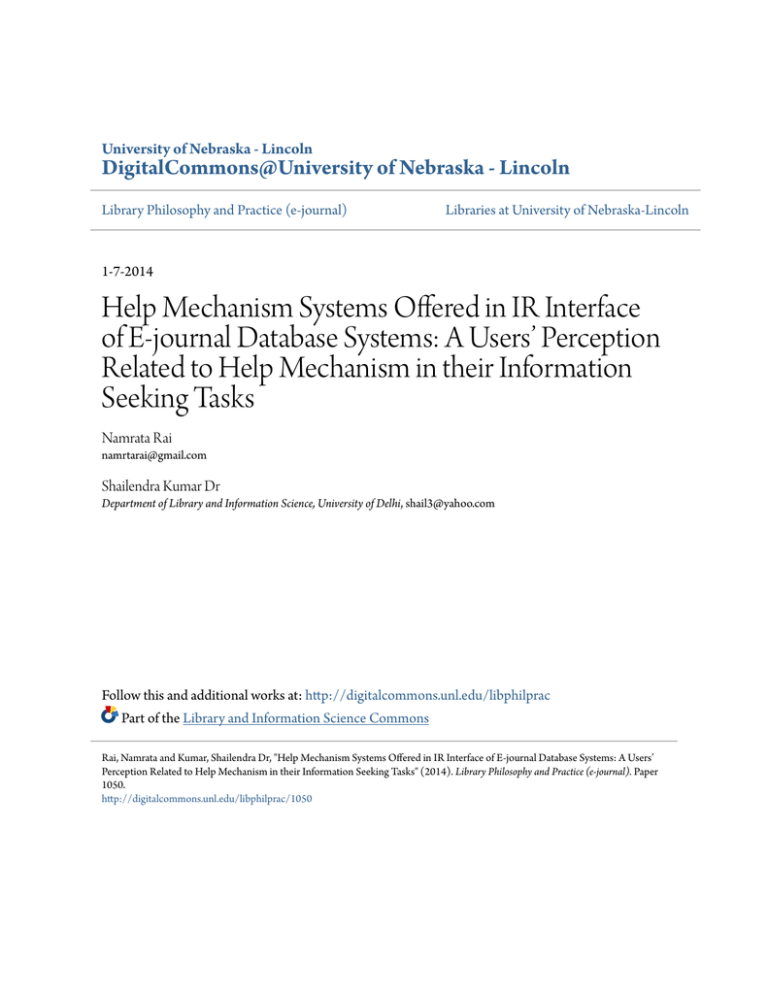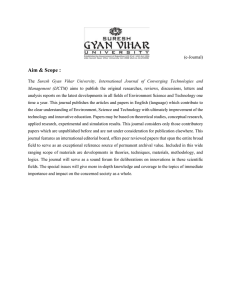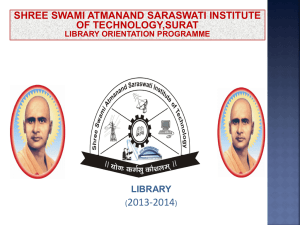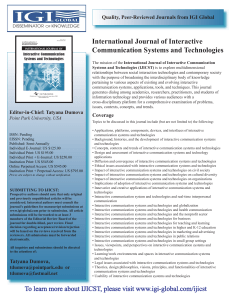Help Mechanism Systems Offered in IR Interface of E
advertisement

University of Nebraska - Lincoln DigitalCommons@University of Nebraska - Lincoln Library Philosophy and Practice (e-journal) Libraries at University of Nebraska-Lincoln 1-7-2014 Help Mechanism Systems Offered in IR Interface of E-journal Database Systems: A Users’ Perception Related to Help Mechanism in their Information Seeking Tasks Namrata Rai namrtarai@gmail.com Shailendra Kumar Dr Department of Library and Information Science, University of Delhi, shail3@yahoo.com Follow this and additional works at: http://digitalcommons.unl.edu/libphilprac Part of the Library and Information Science Commons Rai, Namrata and Kumar, Shailendra Dr, "Help Mechanism Systems Offered in IR Interface of E-journal Database Systems: A Users’ Perception Related to Help Mechanism in their Information Seeking Tasks" (2014). Library Philosophy and Practice (e-journal). Paper 1050. http://digitalcommons.unl.edu/libphilprac/1050 Help Mechanism Systems offered in IR Interface of E-journal Database Systems: A Users’ Perception related to Help Mechanism in their Information Seeking Tasks Dr. Shailendra Kumar Department of Library and Information Science University of Delhi Namrata Rai Department of Library and Information Science University of Delhi Abstract The aim of the study is to know about the various help features offered in IR Interface of E-journal database systems and also taking feedback from the users regarding use and non-use of those help features in their search related activities. Qualitative feedback also taken from the respondents related to the reasons about not using help mechanism functionality offered in the IR interface of E-journal Database systems. Total 305 respondents participated in the study. The study employs a checklist method and questionnaire method for collecting of information. For qualitative data interview method was preferred. The Findings of the study reveals that users were not expressing their high level perceived importance towards using help features available in IR Interface of Ejournal Database systems. Keywords: Help Mechanism, IR Interface, E-journal Database Systems, Information retrieval 1.0 Introduction Today many Information Retrieval systems are directly used by end- users’. Because of the absence of a human intermediary, users face a difficulty in search processing task, because they have to know how to interact directly with the system and cope with various kinds of problems: learning interface commands, using Boolean logic, preferring the more effective terms and designing and applying effective search strategies (Brajinik, Mizzaro and Tasso 2001, P. 343). So much research has been carried out into developing information retrieval (IR) systems with automated searching assistance in order to address some of the issues users have when searching. Automated assistance systems attempt to aid the user during the search process by either executing search tactics or offering assistance to the user to improve the probability of locating relevant information. These systems rely many times on implicit feedback (Jansen and McNeese 2005, P. 1480). So, help mechanism offered in IR Interface of Information Retrieval System is a kind of service which plays an essential role in helping users to effectively use the systems and to retrieve information as they desired. Automated assistance systems usually attempt to assist the users during the search process by either executing search tactics for or offering assistance to the user in order to help to locate relevant information. Automated Assistance can define as any expression, action, or response of an IR system with the aim of improving the information searching experience for the users as measured by some external metrics. These external metrics are usually relevance related ones, such as precision. (Korfhage 1997). 2.0 Literature Review For the study, few studies related to help mechanism functionality were presented which assist users’ during their entire information retrieval task. Automated searching assistance resolved some of the issues users have when interacting with information retrieval (IR) systems. These searching include failure to obtain sufficient relevant information and not understanding searching features of the system. Automated assistance systems attempt to assist the user during the search process by either executing search tactics for or offering assistance to the user in order to locate relevant information. The success of these intelligent systems depends in part on their ability to get appropriate advice or action at opportune times (Jansen 2005, p. 910). Kreymer (2002) discuss the structure and component of the systems’ help mechanism and claimed to be using natural language searching in fact used a wide range of information retrieval techniques from real natural language processing to Boolean searching along with that Non-expert users who directly interacting with an IR system, apply a limited portfolio of simple actions. They do not know how to respond in critical situations and they often do not even realize that their troubles are due to strategic problems. An interface to an IR system should therefore offer some strategic assistance, focusing user’s attention on strategic issues and providing tools to generate better strategies. Because neither the user nor the system can autonomously solve the information problem, but they complement each other, the study proposes a collaborative coaching approach, in which the two partners cooperate: the user retains the control of the session and the system provides suggestions. The effectiveness of the approach is demonstrated by a conceptual analysis, a prototype knowledge-based system named FIRE (Brajnik et.al. 2002). Advances in search technology have meant that such arrangements can directly offer assistance to users beyond simply retrieving a set of text files. For example, such systems are now capable of inferring user interests by watching their interaction, offering hints about what terms could be used in a query, or reorganizing search results to make exploration of retrieved material more effectively. When providing new search functionality, system designers must determine how the new functionality should be provided to users. One major alternative is between (a) offering automatic features that require little human input, but give little human control; or (b) interactive features which allow human control over how the feature is used, but often give little guidance over how the feature should be best used (White and Ruthven 2006). Jansen and Mcneese (2005) evaluate the automated assistance feature to determine whether automate assistance improves search performance and when searchers desire system intervention in the search process. Forty participants interacted with two fully functional information retrieval systems. The systems were identical in all respects except that one offered automated assistance and the other did not. The study used a client-side automated assistance application, an approximately 500,000-document Text REtrieval Conference content collection, and six topics. Results indicate that automated assistance can improve search performance. However, the improvement is less dramatic than one might expect, with an approximately 20% performance increase, as measured by the number of users selected relevant documents. Zumer (2000) draws attention towards help mechanism offered in IR Interface of eJournal Database Systems. In the study, it acknowledged that users often felt difficulties when using an e-Journal Database System for query formulation. The help function offered in IR Interface of e-Journal Database Systems have to available at all times and it has to be very clear and well structured and well written, the nomenclature used in helper function should not be very technical and it can be utilized by the users who are having different level of experience of searching. In the study, categorization of help system were also done like help function can be any type(s) a printed, online manual, error messages, contextual help and user guidance etc. Cool and Xie (2004) claim that help system is often the only resource that the user can consult when they are facing problems related with the use of IR systems. In the study, it gets noticed despite of the importance of the help systems in an interactive IR, people use this resource infrequently, for a variety of reasons. 3.0 Research Questions The study addresses the following research questions which coded as RQ1, RQ2 and so on. RQ1. What are the help features offered by IR Interface of E-journal Database Systems for the users? RQ2. Users’ perceived importance towards use of help features offered by IR Interface of E-journal Database Systems? RQ3. Users’ feedback regarding to no use of help features offered by the IR interface of E-journal Database systems. RQ4. For which E-journal Database systems’ help features, users’ show high level perceived importance? 4.0 Research Methodology 4.1. Sample: For the study, first help mechanism of E-journal Database Systems get evaluated by the researcher through expert study, in the study total 10 E-journal Database Systems were selected. Selection of databases was performed on the basis of their coverage (Either purely based on Social Science discipline or multidisciplinary by nature but covering maximum social science disciplines). So, help mechanism of 10 E-journal Database systems selected for the study was as follows: (the E-journal database arranged here alphabetically) 1.0 EBSCO 2.0 EMERALD 3.0 H. W. Omni File Full-text 4.0 JSTOR 5.0 Oxford University Press 6.0 Project MUSE 7.0. ProQuest Direct 8.0 Sage 9.0 Springer 10.0 Taylor and Francis Online After evaluating the IR Interface of help mechanism offered by selected E-journal database systems, users’ perception were recorded for the study. The users selected for the study consists of researchers including PhD and M. Phil Scholars from three target universities i.e. University of Delhi, Jamia Milia Islamia University and Jawaharlal Nehru University and hence belonging to the target population for the IR system studies. In the study, random sampling was difficult to implement, due to several factors: particularly the complexity of data gathering methods and the fact that the exact population using these IR Interface of E-journal Database Systems is hard to define. So, only those respondents were selected for the study that was aware of at least two E-journal Database Systems among all selected E-journal Database Systems. In the main part of the study, total 305 respondents were participating. 4.2. Methods of Data Gathering: In the study, for evaluating the help mechanism of IR Interface of selected E-journal Database Systems, Checklist method was employed. After evaluating the help mechanism of IR Interface of E-journal database systems, questionnaire method was employed for recording users’ perception about help mechanism and at what extent those help mechanism provide help into their search related activity. In a questionnaire, different set of questions was articulated which include open ended, close ended and Likert type questions. 4.3. Use of Data from Different Sources: Here in the study, data were collected from two different sources. In the first phase of the study, by utilizing the checklist method, researchers explored all the help features offered in IR Interface of E-journal Database Systems and at a later stage, for knowing the users’ perception regarding usability of those help features offered in IR Interface and also trying to know the use- non use of help features by employing questionnaire method. 5.0. Result and Discussion Here, the result of the study divided into two parts. In the first part, it dispenses with the result of evaluation of help mechanism of IR Interface of e-journal database systems and in the second part it deals with the users’ perception and awareness about the help mechanism offered in IR Interface of e-journal database systems. 5.1. Expert study related to the Help Mechanism of IR Interface of E-journal Database Systems This part deals with the findings related to the various help systems offered in IR Interface of all selected E-journal Database Systems. The data were analyzed on the basis of checklist method and observation. The checklist was prepared carefully keeping expert suggestions in mind who were dealing in this particular area. So, table 1 enlisted all help features offered in IR Interface of E-journal Database Systems and the comparative results were presented: Help Features Online Help/ Search Screen Help Contextual Help Field Information Full Documentation Spell-Check Error IR Interface of E-journal Database Systems Springer Sage JSTOR MUSE OUP ProQuest T& F Online YES Wilson Web NO YES YES YES YES YES YES NO NO YES YES YES YES YES YES YES YES YES YES YES YES YES YES YES YES YES YES YES YES YES YES YES YES YES YES YES YES YES YES YES YES YES YES YES YES YES YES NO EBSCO EMERALD YES Table 1: Help Features offered in IR Interface of selected E-journal Database Systems Table 1 presented the findings of comparative results of help features offered in IR Interface of E-journal Database systems. Though all the commercial E-journal Database systems were taken for the study and most of them follow accepted guidelines and standards while designing their respective interface. So, very less variation found in term of offering help features to the users during search process. But, here findings get elaborated under different features individually. A) Online Help/ Search Screen Help Online help/ Search screen, it usually means short search tips which help the user by explaining what can be done at a certain phase of the user’s work. All the systems provide search screen help on demand, mostly in the “Advanced” level. But Wilson web and T&F online doesn’t offer search screen help to the users. B) Contextual Help All the systems also offer examples of queries. All the systems offer online manuals. The structure is similar, all of them having built-in search capabilities, table of contents and index. ProQuest Direct also offers several languages – the language corresponds to the language of the interface – and includes a glossary of terms. Consistency and linguistic appropriateness proved to be high. In all systems, help is terminologically consistent with the system and linguistically correct. Context help could be found in all systems; EBSCO Host is the only system not to offer it. C) Field Information In all the systems it proved to be accurate, though relatively general. For example, when searching the user can find help about searching at the level that is currently being used, but not, for example, about individual search fields D) Full-Documentation Full- Documentation about the every aspects and functions of E-journal Database Systems were available either in online or manual form. E) Spell-Check Error Spellchecker launches automatically by the E-journal Database System when results are returned for a search. The feature suggests alternate spelling for proper names, corporate names and any other words that produce no hits. Except T&F online, each IR system offering Spell checker mechanism. 5.2 Users’ Feedback regarding to usability of Help Features offered in IR Interface of E-journal Database Systems Help mechanism plays an indispensable role in helping users to effective use of e-journal database system and to retrieve information. While using system in general and especially during the information retrieval (IR) process, user need a variety of types of assistance when they encounter problems, especially when they use systems that are new to them. Here table 2 deals with users experience with help mechanism system offered by Ejournal Database Systems to provide assistance to the users during their search related activities. Table 2 pointed out that how many respondents were aware and used this help mechanism system and those who are not using it this functionality and their causes which lead them to not use this function in IR interface of e-journal database system. The reasons coded here as R1, R2 and so on, and the reasons are as follows: R1 = Give Preference to human help R2 = Lack of solution or relevant help R3 = Unclear instruction; inability to use help mechanism R4 = Individual Problem solving style R5 = lack of Knowledge of help system R6 = Lack of adequate explanation R7 = Insufficient Instruction Ever used help Mechanism No Yes 191 (62.62%) Importance Not at all A little Somewhat Somewhat more Extremely 114 (37.38%) Counts 4 11 47 90 39 % 2.1 5.8 24.6 47.1 20.4 Reasons for not using R1 R2 R3 R4 R5 R6 R7 Counts 70 11 17 41 41 7 5 Table 2 Usability of Help Mechanism offered in IR Interface of E-journal journal Database Systems % 61.4 9.65 14.91 35.96 35.96 6.14 4.39 In table 2, out of 305 respondents who used different e-journal database systems selected in the study, only 62.62% respondents were aware of and using this help mechanism functionality offered by IR interface of e-journal database system. So, 191 (62.62%) respondents who are using this e-journal help mechanism system, when asked that at what extent e-journal help mechanism is important to them during their search process? Only 2.1% respondents consider help mechanism “Not at all important”, while almost half (47.1%) said that help mechanism were “Somewhat more important” and even a good amount of respondents believe this functionality “Somewhat important” (24.6%). At the same time 37.38% (114) respondents were not using this help mechanism functionality offered in IR Interface of E-journal Database systems. When asked to the users’ about the reasons behind not using this help mechanism functionality. Respondents provide their respective reasons as well. The most prominent reason responded by the users that they give “Preference to human help (61.4%)”. The second most important reason responded by the users were given by that they have “Individual Problem solving style (35.96%)” and “Lack of knowledge of help system (35.96%)”. These are the most prominent reasons given by the respondents who are not using e-journal help mechanism system. For supporting their most prominent reasons behind not using this help mechanism functionality respondents give their proper justification as well. (R1) Give preference to human help Under this they have different opinions like some of them said that “Rather than reading the whole instruction they prefer those persons who already used this database for searching. (U 40)”. “In some cases, User find easier to ask someone for help during their search in IR interface (U17)” “Sometimes, they rely on experts who are good in searching rather than using system help (U 25)”. The second most prominent reasons supported by the respondents who are not using e-help mechanism in interface of e-journal database system was (R4) Individual Problem Solving Style. Users have their own views for opt this reason few reasons are cited here which were supported by maximum users. “Trial and Error method is the best way to learn (U24)”. “Rarely using a help mechanism because they prefer to do things or search by their own intellect (U 19)” (R5) Lack of Knowledge of help system This is another common and prominent problem supported by the respondents that prevents them from not using the help system. In fact most of them don’t know that such kind of facility also exists. Few of them said that, “I don’t use them because, I am unaware of how they function and the ease in searching they provided (U12)” “I didn’t look for e-help provided in interface of e-journal database system therefore I was unaware that such kind of facility was available in e-journal database systems (U 28)”. 5.2.1. Frequency of using Help Mechanism in IR Interface of E-journal Database Systems Those who are using help mechanism offered in interface of E-journal Database System when asked that how frequently they used help mechanism in e-journal database system. Here, Table 3 pointed out the frequency of using help mechanism functions by the users. Frequency of usage of e-journal help mechanism Counts % Never 115 37.7 Rarely 12 3.93 Occasionally 92 30.16 Often 74 24.26 Every time IR system used 12 3.93 Table 3: Frequency of using Help Mechanism offered in IR Interface of E-journal Database Systems Table 3 discuss that although our respondents were aware of this help mechanism functionality and they are also using it but only 30.16% respondents “occasionally” used it this mechanism when they interact with system but at the same time quite a good amount of respondents like 24.26% were “often” used this function for their problems facing during their search in interface of e-journal database system. 3.93% respondents were “Rarely” using this function and simultaneously 3.93% respondents used help mechanism “Every time when the IR system used”. 5.2.2. Usefulness of Help Mechanism functionality offered in IR Interface In this part, respondents have to respond that how well the help mechanism offered in interface of E-journal Database System assist respondents in their various search related activities. These activities for which help systems might play a role in assisting the users are listed below: Assistance of help mechanism among user of e-journal database systems (n=190) Assist in identifying problems Assist in locating information Assist to find relevant information Help to understand explanation Rate interaction with help mechanism Counts % 86 57 80 78 3 45.16 30 42.11 41.05 1.58 Table 4: Assistance offered by help mechanism functionality offered to users’ during their search process From table 4 explain that all the help seeking functions that offered in interface of ejournal database system might assist users with during the course of a searching. Out of 190 respondents 45.16% respondents supports that they were using e-help system for “Identifying the problem”. 42.11% respondents used it for “Finding relevant information”. Some of them used this function for “to understand the explanation (41.05%)”. 5.2.3. Importance of Help Mechanism Functionality offered in IR Interface of Ejournal Database Systems Here in Table 5 presented the findings related to respondents experience with the help mechanism offered by IR Interface of selected E-journal Database Systems. It shows how much interface of one e-journal database systems varies in terms of offering help mechanism functionality with others. For knowing the importance, regression analysis gets conducted. Here dependent variable ‘Perception of Importance’ is taken as a linearly increasing variable. Mean Exp (Coef.) Std. Err. t P>t [95% E-Journal Databases EBSCO 3.86 1.32 0.21 EMERALD 3.60 0.86 0.19 ProQuest 3.45 0.63 0.09 JSTOR 3.77 0.91 0.29 Wilson Web 3.58 0.95 0.26 Springer MUSE Sage 3.75 3.87 3.80 0.97 1.18 1.37 0.13 0.16 0.20 OUP 3.75 0.95 0.14 1.76 0.71 3.06 0.31 0.18 0.21 1.21 2.21 0.31 0.66 0.081*** 0.479 0.003** 0.754 0.860 0.837 0.228 0.028* 0.757 T&F online 3.69 0.91 0.13 0.511 overall mean importance 3.71 *1% level of Significance ** 5% level of Significance *** 10% Level of Significance Here from Table. 5, it shows that respondents who were using ProQuest and Sage databases have reported significantly increasing importance help mechanism from its mean value whereas users of EBSCO reported significantly declining importance of help mechanism in comparison to other database users. 6.0 Conclusion The nature of Information Retrieval System is interactive and interface/system design should support users to effectively interact with information and system. To some extent the interactive characteristics of IR interface facilitates users’ interaction with information and system. However, from this study it concludes that there are still some issues are unexplored and required more attention like, how the help mechanism functionality of Information Retrieval interface of e-journal database system get designed that user can more rely on this function and considering this function first as a help rather than taking external help for searching? Hence from the study, evaluation of help mechanism features of IR Interface of e-journal database system revealed that most of the help features were supported by all selected ejournal database system, only few features like online help/search screen help, contextual help and spell check References Brajnik, G., Mizzaro, S., Tasso, C. and Venuti, F. 2002, ‘Strategic Help in User Interfaces for Information Retrieval’, Journal of American Society for Information Science, Vol. 53 No.5, pp. 343-58. Cool, Colleen and Xie, Hong (Iris). (2004), “How can IR Help Mechanism be more helpful to the users?” Proceedings of the 67th ASIS&T Annual Meeting, Vol. 41, pp. 249- 255. Jansen, B.J. 2005, ‘Seeking and implementing automated assistance during the search process’, Information Processing and Management, Vol. 41 No.4, pp. 909-928. Jansen, B.J. and McNeese, M.D. 2005, ‘Evaluating the Effectiveness of and Patterns of Interactions With Automated Searching Assistance’, Journal of American Society for Information Science, Vol. 56 N.14, pp. 1480-03. Korfhage, R. (1997), “Information Storage and Retrieval ”, New York, NY: Wiley Kreymer, Oleg (2002), “An Evaluation of help mechanisms in natural language information retrieval systems”, Online Information Review, Vol. 26 N. 1, pp.30-39. White, R.W. and Ruthven, I. 2006, ‘A Study of Interface Support Mechanisms for Interactive Information Retrieval’, Journal of American Society for Information Science, Vol. 57 No.7, pp. 933-48. Zumer, M. (2000), “User interfaces of national bibliographies on CD-ROM: results of a survey”,Program, Vol. 34 No. 3, pp. 281-90.




